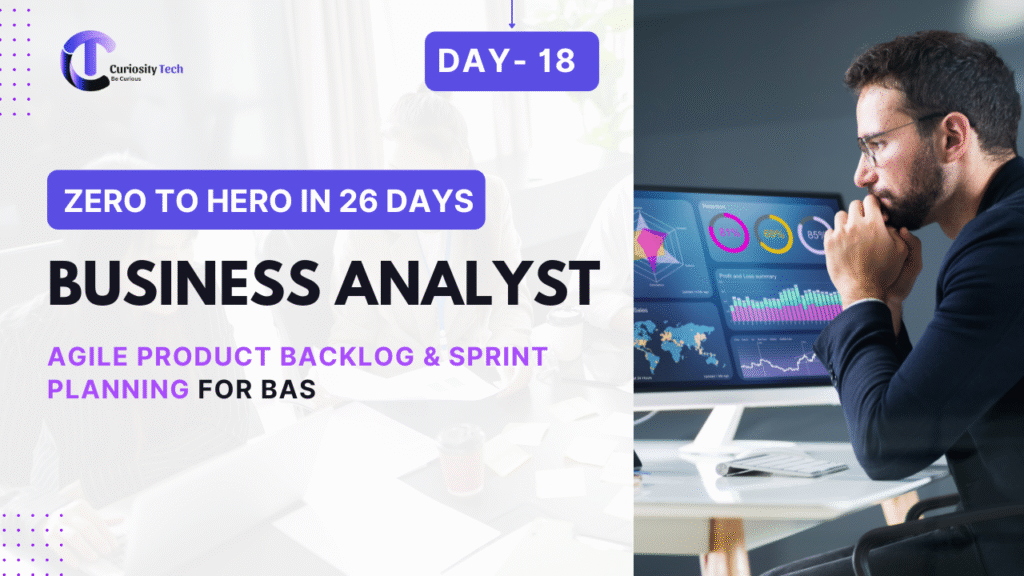Introduction
In Agile environments, clarity, prioritization, and adaptability are essential. Unlike traditional waterfall projects, Agile thrives on iterative progress and continuous feedback. Two critical tools that make this possible are the Product Backlog and Sprint Planning. For Business Analysts (BAs), mastering these practices ensures smooth collaboration with Product Owners, Scrum Masters, and Developers.
At Curiosity Tech (website: curiositytech.in, Phone: +91-9860555369, Email: contact@curiositytech.in), we train analysts to move beyond documentation and actively facilitate Agile ceremonies, making them key contributors to sprint success.
1. Product Backlog – The Heart of Agile
The Product Backlog is a living, ordered list of everything that needs to be built in the product. It evolves constantly as business priorities shift.
Characteristics of a Product Backlog:
- Dynamic: Items are added, removed, or re-prioritized.
- Prioritized: Most valuable items are placed at the top.
- Detailed progressively: High-priority items are clearer, while lower ones are more abstract.
Example (E-commerce Platform Backlog):
- Epic: User Account Management
- User Story: As a user, I want to register with my email so that I can create an account.
- User Story: As a user, I want to reset my password so that I can regain access.
- User Story: As a user, I want to register with my email so that I can create an account.
- Epic: Shopping Cart
- User Story: As a customer, I want to add items to a cart so that I can purchase multiple items together.
- User Story: As a customer, I want to add items to a cart so that I can purchase multiple items together.
- Epic: Payment Gateway Integration
- User Story: As a customer, I want to pay securely online so that I can complete my order.
2. Writing Good User Stories
A user story is the basic unit of backlog items.
Format:
👉 As a [role], I want [feature], so that [benefit].
Best Practices (INVEST model):
- Independent: Can be developed separately
- Negotiable: Open to discussion
- Valuable: Delivers business value
- Estimable: Size can be estimated
- Small: Fits within a sprint
- Testable: Can be validated

3. Sprint Planning – From Backlog to Action
Once backlog items are ready, sprint planning begins.
Key Steps in Sprint Planning:
- Review Product Backlog → What’s most valuable now?
- Set Sprint Goal → Define the objective for this sprint.
- Select Stories → Team picks backlog items based on velocity.
- Break into Tasks → Each story is decomposed into smaller tasks.
- Estimate Effort → Story points or hours are assigned.
Example Sprint Planning (2-Week Sprint):
| Sprint Goal: Enable secure checkout |
| Selected Stories |
| – Add items to shopping cart |
| – Implement checkout page |
| – Integrate payment gateway (basic) |
| Tasks |
| – Design cart UI (4 hrs) |
| – API integration (8 hrs) |
| – Payment testing (5 hrs) |
4. Tools That Support BAs in Backlog & Sprint Planning
- JIRA – Most widely used for backlog management and sprint boards
- Trello – Simple Kanban-style board
- Azure DevOps – For enterprise projects
- Confluence – For backlog documentation and acceptance criteria
At Curiosity Tech, interns and analysts work on live backlog grooming sessions using JIRA, simulating real corporate sprint cycles.
5. Role of Business Analysts in Agile
- Backlog Grooming: Refining backlog items with Product Owner
- Clarifying Requirements: Ensuring user stories are testable and aligned with business goals
- Facilitating Sprint Planning: Translating business needs into actionable tasks
- Stakeholder Communication: Keeping priorities aligned across teams
- Acceptance Criteria Definition: Making sure “done” is clearly understood
6. Visual Example – Backlog to Sprint Board
Product Backlog
├── Epic: Shopping Cart
│ ├── Story: Add items to cart
│ ├── Story: View cart summary
│ └── Story: Remove items
└── Epic: Payments
├── Story: Integrate credit card payment
└── Story: Add UPI option
Sprint Board (Current Sprint)
To Do: [Add items to cart]
In Progress: [Design checkout page]
Done: [Create cart summary]

7. Case Study – Agile Banking App
Scenario: A banking client in Pune wanted to launch a mobile app within 4 months.
BA Contribution (Curiosity Tech team):
- Conducted backlog workshops with stakeholders
- Wrote 100+ user stories covering KYC, funds transfer, and bill payment
- Facilitated sprint planning sessions every 2 weeks
- Used story points to estimate velocity and track progress
Outcome:
- Minimum Viable Product (MVP) launched in just 3 sprints
- Stakeholder satisfaction increased due to continuous delivery
- Post-launch change requests were absorbed easily into future sprints
8. Best Practices for BAs in Agile Planning
- Always keep backlog items aligned with business value
- Use MoSCoW method (Must, Should, Could, Won’t) for prioritization
- Encourage cross-functional discussions during sprint planning
- Keep acceptance criteria clear and measurable
- Support Product Owner, but don’t overlap roles — be a bridge, not a blocker
9. Hierarchical Summary – Agile Flow
Vision
└── Product Backlog
└── Sprint Planning
└── Development & Delivery
└── Review & Feedback

10. Conclusion
The Product Backlog and Sprint Planning are more than Agile rituals — they’re value delivery engines. For Business Analysts, mastering them means being at the core of product success. By learning to write clear user stories, prioritize smartly, and facilitate sprint discussions, analysts drive continuous business value.
At Curiosity Tech, our programs emphasize practical Agile exposure, ensuring BAs are job-ready with backlog grooming, sprint facilitation, and Agile collaboration skills. Whether you’re working on an e-commerce startup or a banking enterprise, backlog and sprint planning mastery is the difference between chaos and clarity.

